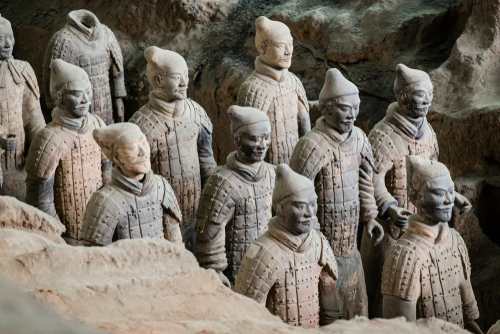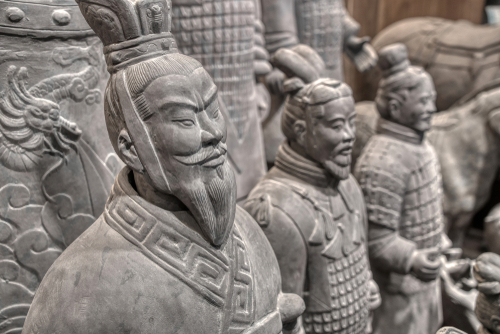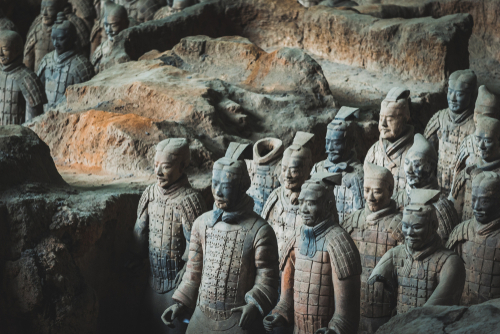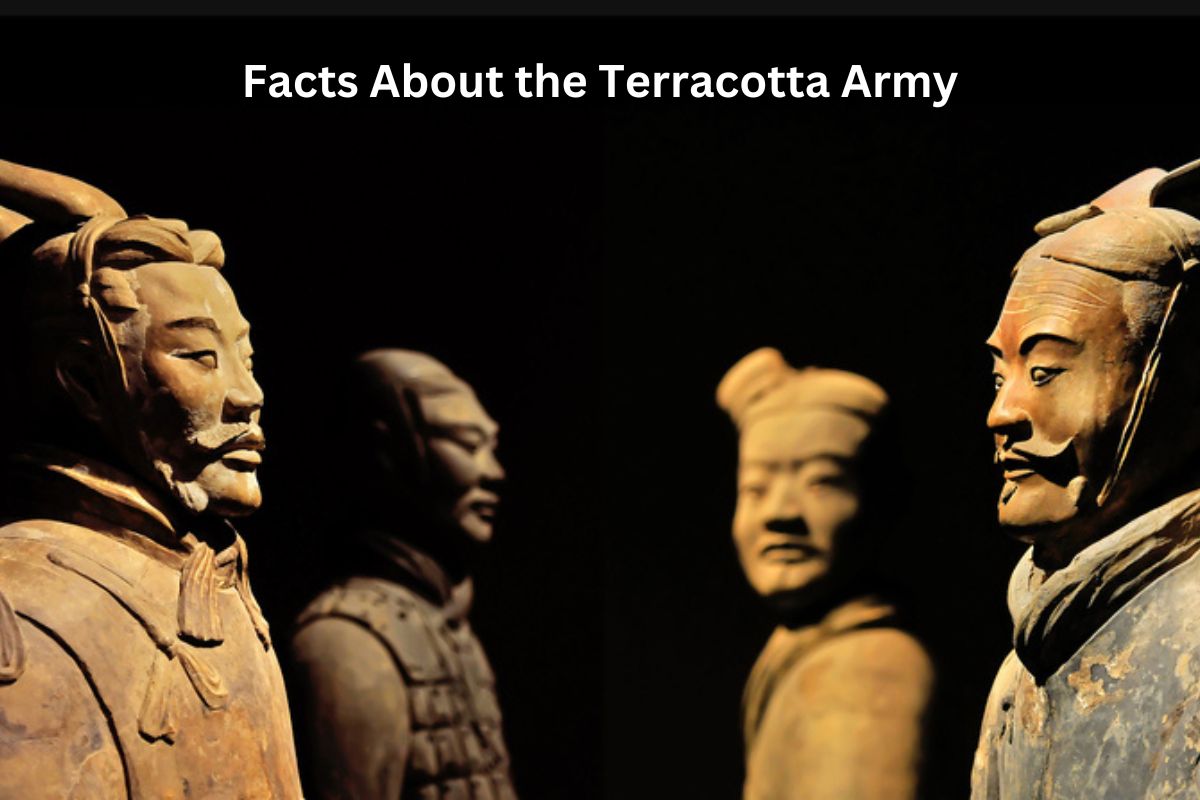The Terracotta Army stands as an extraordinary testament to ancient Chinese culture and military prowess. Unearthed in 1974 near Xi’an, China, this archaeological marvel comprises thousands of life-sized clay soldiers, horses, and chariots meticulously crafted over two millennia ago.
Created to accompany Emperor Qin Shi Huang into the afterlife, these figures not only showcase remarkable artistic detail but also provide insights into the military organization and spiritual beliefs of the Qin Dynasty.
As a UNESCO World Heritage Site, the Terracotta Army continues to captivate the world’s imagination, inviting us to explore the rich history and cultural legacy of ancient China.
Terracotta Army Facts
1. Discovered in 1974 near Xi’an, China
The Terracotta Army was accidentally discovered by a group of local farmers digging a well near the city of Xi’an, located in the Shaanxi province of China.
Also Read: Ancient China Facts
While digging, they unearthed fragments of a clay figure, which led to the realization that something significant lay beneath the ground.

2. Found in Emperor Qin Shi Huang’s mausoleum
The Terracotta Army is situated within the vast mausoleum complex built for China’s first emperor, Qin Shi Huang. This complex is located near the ancient capital of Xi’an and covers a substantial area. The army’s purpose was to guard and protect the emperor’s tomb in the afterlife.
3. Thousands of life-sized clay soldiers, horses, and chariots
The Terracotta Army consists of an astounding number of life-sized terracotta figures. Estimates suggest that the army comprises over 8,000 soldiers, as well as numerous horses, chariots, and other military paraphernalia. These figures were placed in underground pits, each serving a unique purpose.
4. Divided into three pits with different figures
- The Terracotta Army is divided into three separate pits, each with its own layout and assortment of figures. These pits are organized based on the roles the figures were meant to fulfill in the emperor’s afterlife.
- Pit 1 – This is the largest and most well-known pit, featuring a vast array of infantry soldiers in a formation that resembles a battle formation. It is thought to represent the main force of the army.
- Pit 2 – This pit contains cavalry, archers, and infantry, depicting a more diverse range of military roles. It provides insights into the different units that made up the ancient Chinese army.
- Pit 3 – Smaller in size, Pit 3 contains high-ranking officers and commanders. These figures are designed to represent the leadership of the army and showcase a higher level of detail and individuality.
The organization of the Terracotta Army into these three distinct pits provides a remarkable glimpse into the complex military structure and hierarchy of the Qin Dynasty, and it highlights the strategic importance of these figures in the emperor’s concept of the afterlife.
5. Each soldier has unique facial features and clothing
One of the most fascinating aspects of the Terracotta Army is the attention to detail and individuality given to each soldier. Despite being part of a massive collective, the soldiers have distinct facial features, hairstyles, and even clothing.
This individualization showcases the high level of craftsmanship and artistic skill that went into creating these clay figures.

6. Originally equipped with real weapons
When initially created, the terracotta soldiers were equipped with real weapons made of materials like bronze. These weapons included swords, spears, crossbows, and arrows. This attention to authenticity underscores the importance of these figures as guardians for the emperor’s afterlife.
7. Reflects ancient Chinese artistic skill and craftsmanship
The creation of the Terracotta Army represents a remarkable achievement in ancient Chinese artistry. The meticulous craftsmanship required to sculpt each figure, with attention to facial expressions, clothing details, and intricate armor, is a testament to the advanced artistic capabilities of the time.
8. Pits arranged strategically like a military formation
The arrangement of the figures in strategic formations within the pits serves as a testament to the organizational skills of the Qin Dynasty’s military. The positioning of the figures in formations resembling those of a real army highlights the military precision and tactics of the era.
9. Provides insights into Qin Dynasty military organization
The Terracotta Army offers invaluable insights into the military structure and organization of the Qin Dynasty. The varying types of soldiers and their placements within the pits provide researchers with clues about the hierarchy, roles, and functions of different units within the ancient Chinese army.
10. Faces preservation challenges due to exposure
Despite the remarkable preservation of the Terracotta Army over the centuries, the excavation and exposure to air present ongoing challenges for its preservation.
The terracotta figures were originally painted with vibrant colors, but over time, exposure to air and light has caused the colors to fade. Archaeologists and conservators face the delicate task of preserving and restoring these delicate artifacts.
Moreover, the exposure to moisture and environmental changes has led to structural issues and the deterioration of the terracotta material itself. Preservation efforts involve careful excavation techniques, controlled environmental conditions, and innovative conservation methods to ensure the long-term survival of these invaluable historical artifacts.
The Terracotta Army not only provides a window into ancient Chinese military practices and artistic achievements but also poses ongoing challenges for researchers and conservationists to maintain its cultural and historical significance for future generations.

11. UNESCO World Heritage Site since 1987
The recognition of the Terracotta Army’s significance led to its designation as a UNESCO World Heritage Site in 1987.
This acknowledgment highlights the global importance of this archaeological find, not only as a testament to ancient Chinese history but also as a cultural treasure that enriches our understanding of the past.
12. Created to protect Emperor in the afterlife
One of the primary purposes of the Terracotta Army was to provide protection and companionship for Emperor Qin Shi Huang in the afterlife.
The belief was that the army’s presence would help him maintain his rule and authority beyond death, emphasizing the continuity of power and authority in the spiritual realm.
13. Reflects ancient beliefs about power beyond death
The creation of the Terracotta Army reflects the spiritual and religious beliefs of ancient China. It underscores the importance of an emperor’s rule extending into the afterlife, emphasizing the emperor’s divinely ordained role as a leader and protector of his people both in life and in death.
14. Ongoing excavation and restoration efforts
While the initial discovery of the Terracotta Army was groundbreaking, ongoing archaeological efforts continue to shed light on its mysteries. Researchers explore the pits, study the figures, and analyze the surrounding artifacts to uncover new insights about ancient Chinese history, culture, and craftsmanship.
15. Popular global tourist attraction
The Terracotta Army has become a major tourist attraction, drawing visitors from all over the world. Tourists have the opportunity to witness the grandeur of the ancient clay army, learn about China’s rich history, and appreciate the artistic and engineering skills of the Qin Dynasty artisans.
The site also serves as an educational platform, offering insights into the achievements and cultural context of ancient China.
Visitors are not only awed by the scale and artistry of the Terracotta Army but also gain a deeper appreciation for the historical and cultural significance of this archaeological wonder.
As a global symbol of China’s rich heritage, the Terracotta Army continues to captivate people’s imagination and curiosity, inspiring exploration and understanding of the past.
